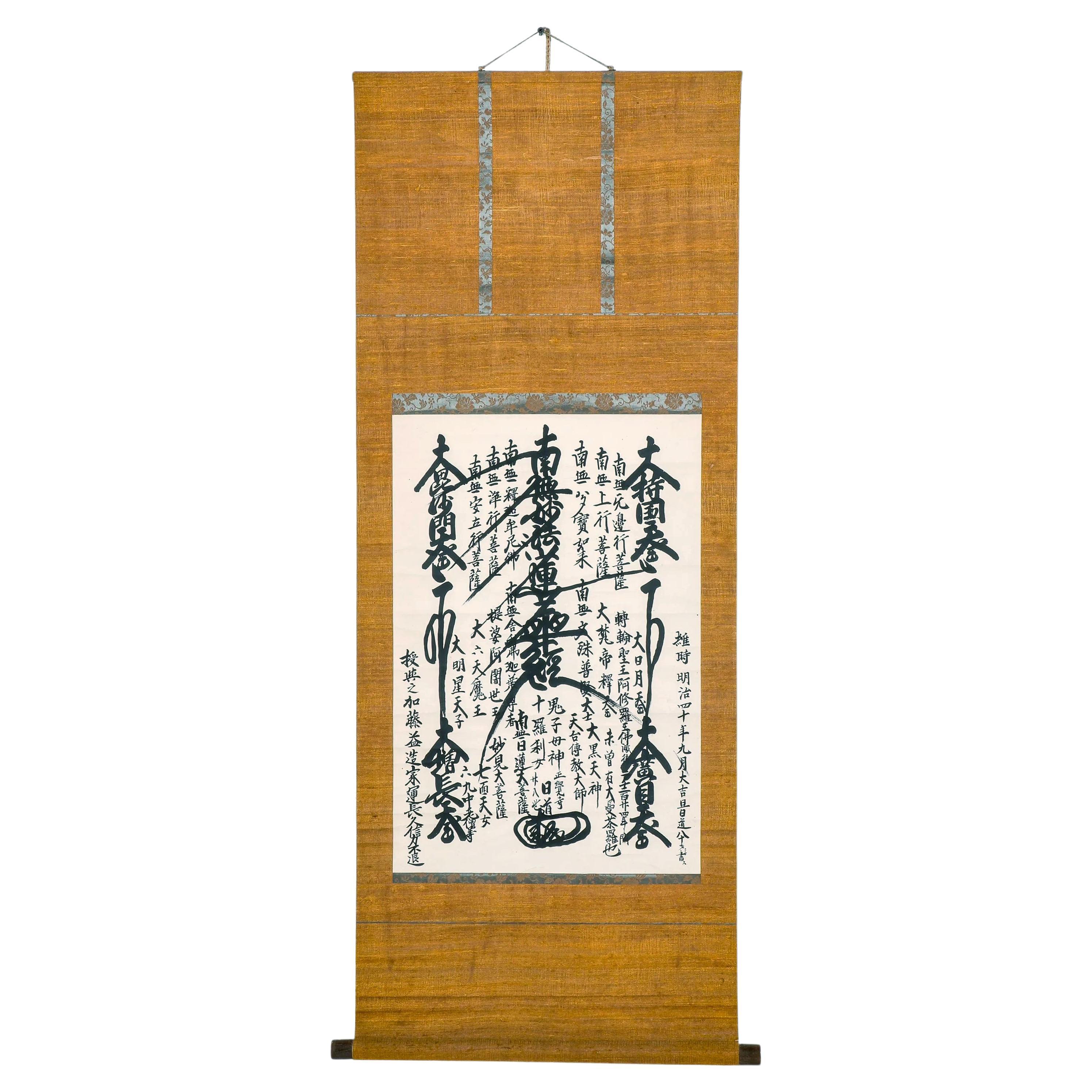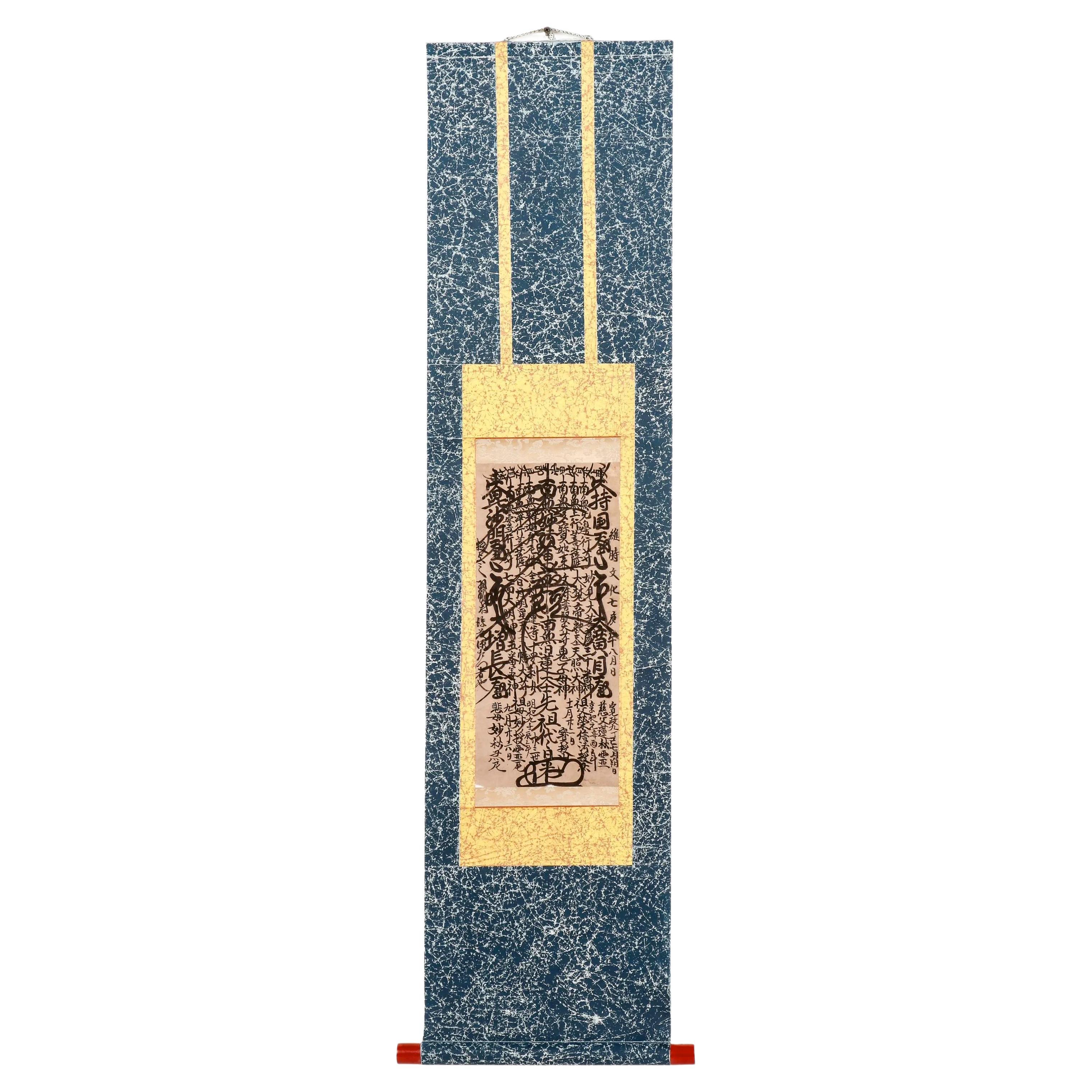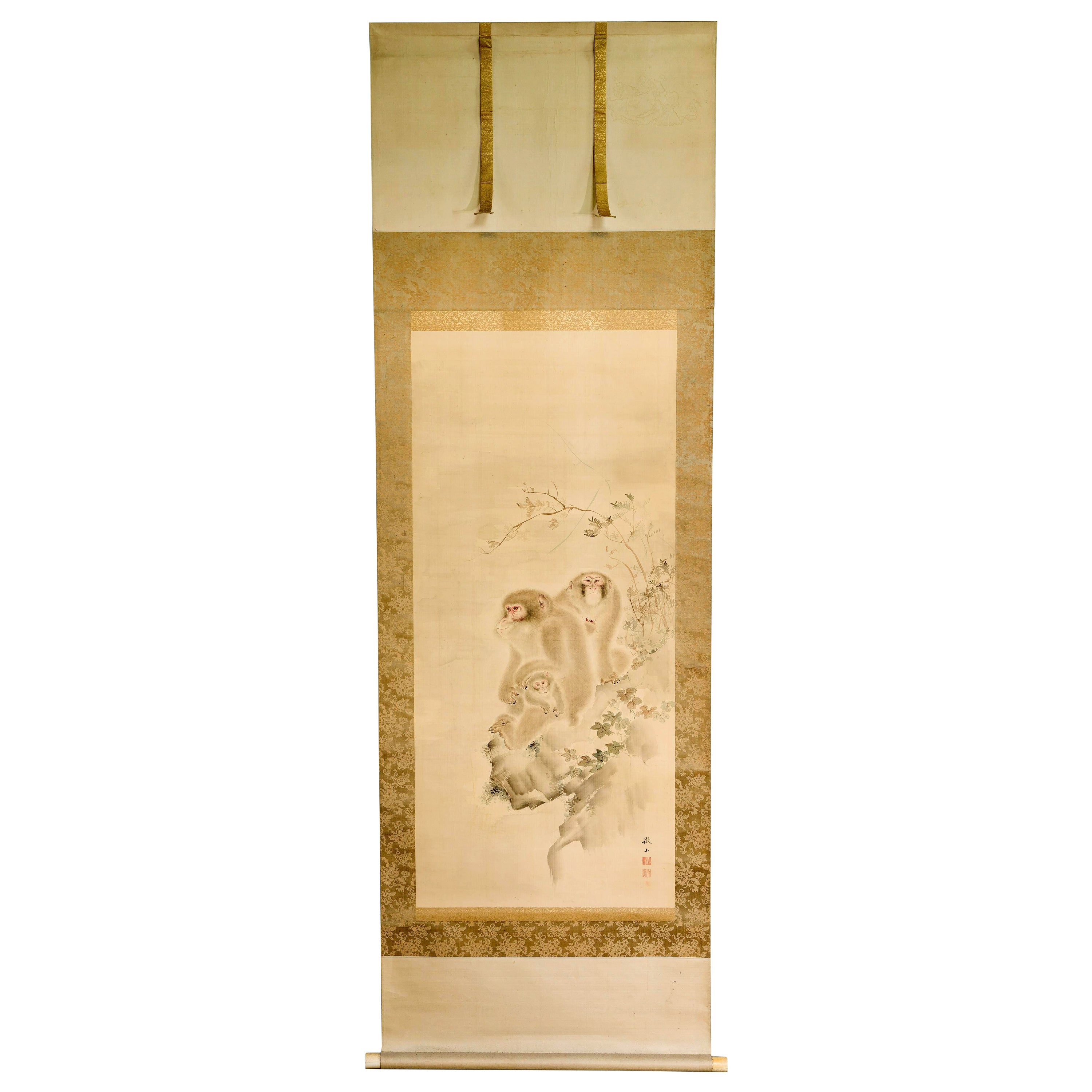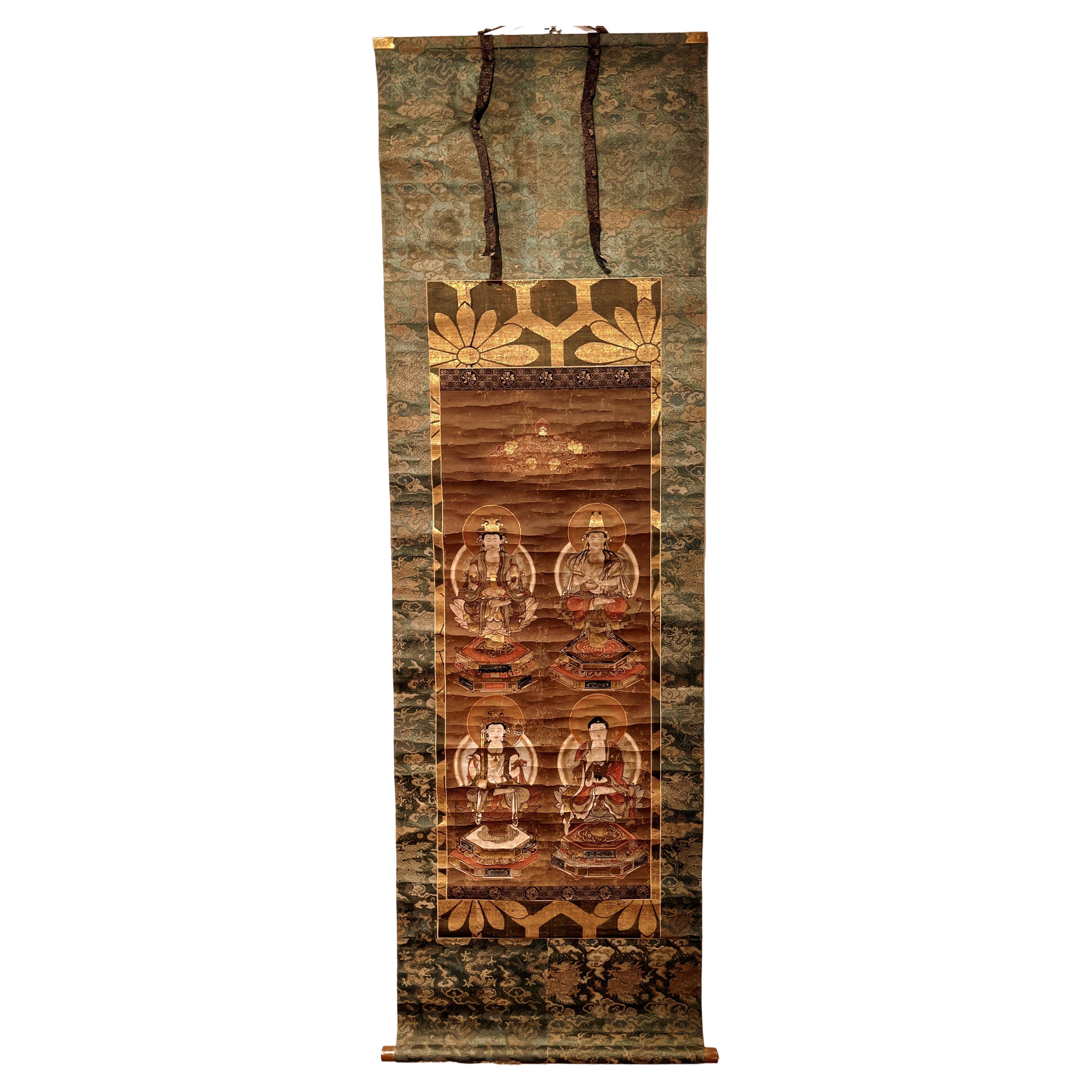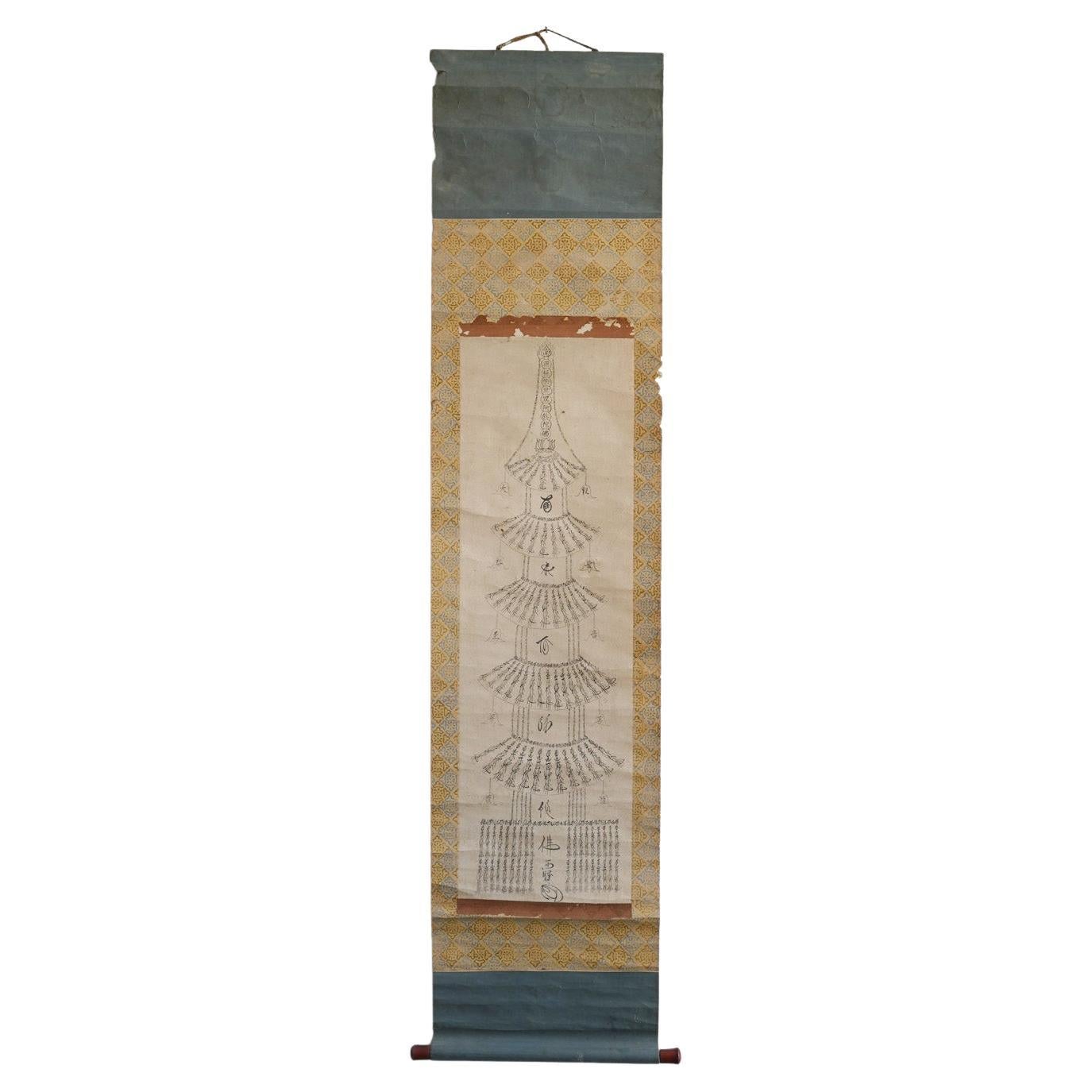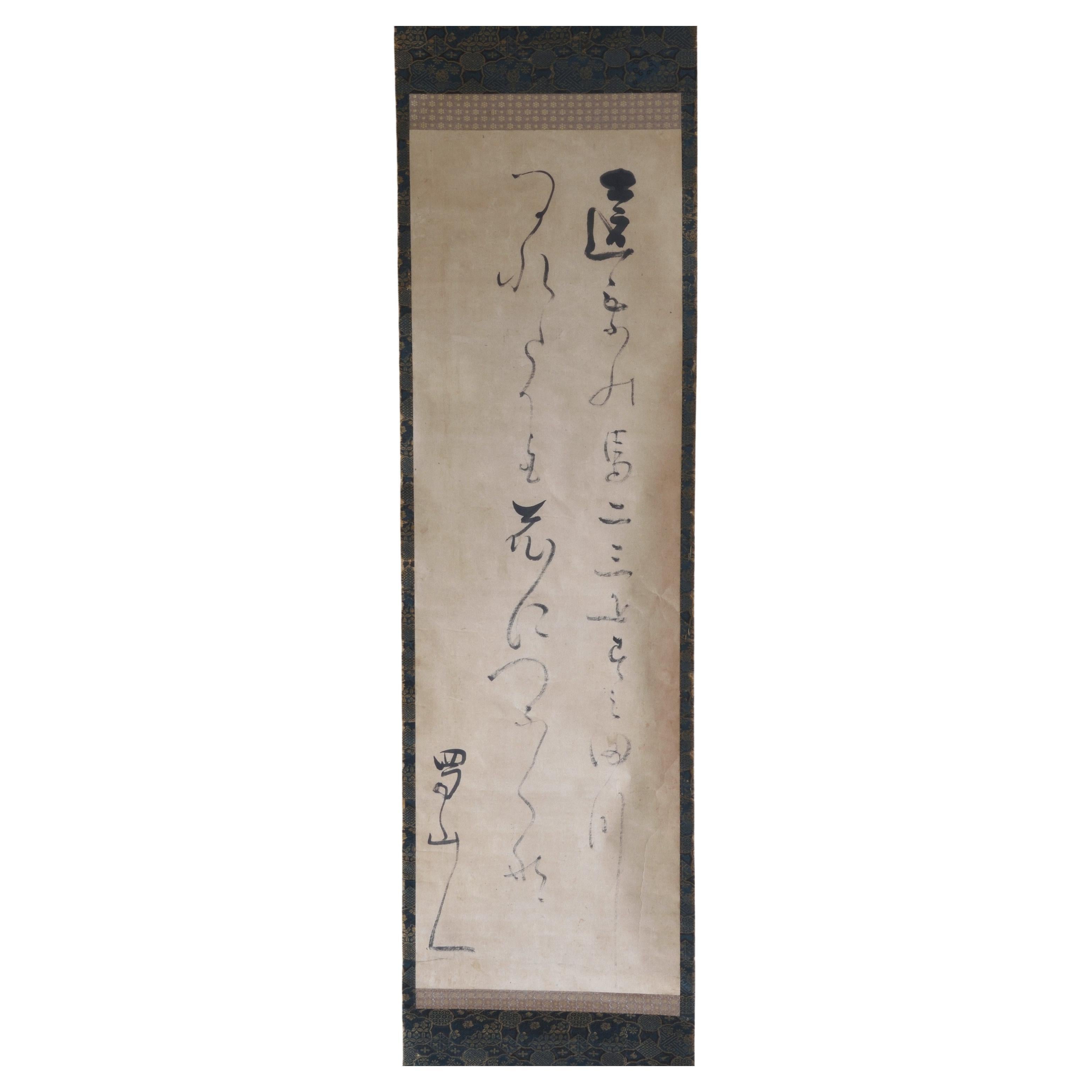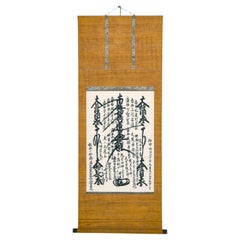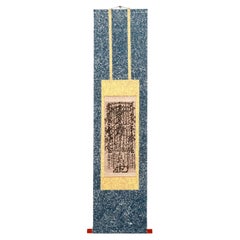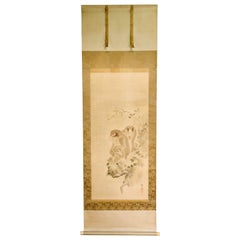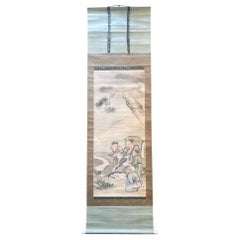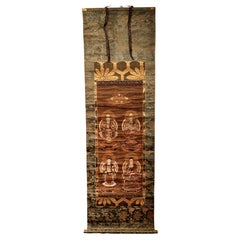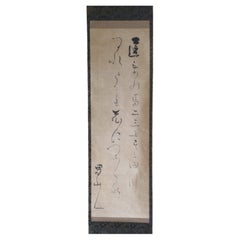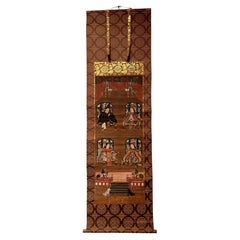Items Similar to Japanese Gohonzon Buddhist Calligraphy Mandala Scroll Meiji Period
Want more images or videos?
Request additional images or videos from the seller
1 of 16
Japanese Gohonzon Buddhist Calligraphy Mandala Scroll Meiji Period
$880
£665.17
€764.40
CA$1,225.39
A$1,363.20
CHF 714.61
MX$16,657.99
NOK 9,099.63
SEK 8,566.04
DKK 5,705.95
Shipping
Retrieving quote...The 1stDibs Promise:
Authenticity Guarantee,
Money-Back Guarantee,
24-Hour Cancellation
About the Item
A Japanese sumi ink calligraphy Buddhist mandala mounted as a paper hanging scroll known as Kakejiku or sometimes Moji mandala. Termed as gohonzon in Japanese, it is a venerated object within Nichiren Buddhism (Hokkeshu; lotus sect). The originally concept was developed by the 13th century Buddhist priest Nichiren to guide the energy of the devotional chanting to the correct direction. The hanging scroll has a prototype design and features stylized Kanji writing of the Buddhist mantra with overflowing and interlacing fashion. It was often made for a specific person and sometimes on a specific occasion (known as Joju gohonzon) for the prays to be answered. Traditionally, the scroll is hanging as part of the accouterment of the shrine installation.
The gohonzon on offer is a Jujo scroll with dedication inscription on the left and date on the right, forming part of the elaborate graphic composition. It was dated to Meiji 29th year (1896). The paper was bordered a graphic paper with chevron pattern. which was also used as two vertical decoration ribbons. A reddish paper was then used as the background mount. Considering that the scroll was dated to 1897, the current mount is likely original based on its condition.
When fully opened, the scroll measures 20" w x 49" h x 0.75"d. The size of the original ink mandala is 14.5" w. x 21" h. It is also inscribed as the dedicated deity and temple on the back of the scroll.
- Dimensions:Height: 1.2 in (3.05 cm)Width: 18 in (45.72 cm)Depth: 1.2 in (3.05 cm)
- Style:Meiji (Of the Period)
- Materials and Techniques:
- Place of Origin:
- Period:
- Date of Manufacture:1896
- Condition:Wear consistent with age and use. Age-appropriate wear with winkles on the mounting paper. Back with minor discoloration.
- Seller Location:Atlanta, GA
- Reference Number:1stDibs: LU945034255922
About the Seller
4.9
Platinum Seller
Premium sellers with a 4.7+ rating and 24-hour response times
Established in 2006
1stDibs seller since 2010
564 sales on 1stDibs
Typical response time: <1 hour
- ShippingRetrieving quote...Shipping from: Atlanta, GA
- Return Policy
Authenticity Guarantee
In the unlikely event there’s an issue with an item’s authenticity, contact us within 1 year for a full refund. DetailsMoney-Back Guarantee
If your item is not as described, is damaged in transit, or does not arrive, contact us within 7 days for a full refund. Details24-Hour Cancellation
You have a 24-hour grace period in which to reconsider your purchase, with no questions asked.Vetted Professional Sellers
Our world-class sellers must adhere to strict standards for service and quality, maintaining the integrity of our listings.Price-Match Guarantee
If you find that a seller listed the same item for a lower price elsewhere, we’ll match it.Trusted Global Delivery
Our best-in-class carrier network provides specialized shipping options worldwide, including custom delivery.More From This Seller
View AllJapanese Gohonzon Buddhist Calligraphy Mandala Scroll Meiji Period
Located in Atlanta, GA
A Japanese sumi ink calligraphy Buddhist mandala mounted as a paper hanging scroll known as Kakejiku or sometimes Moji mandala. Termed as gohonzon in Japanese, it is a venerated object within Nichiren Buddhism (Hokkeshu; lotus sect). The originally concept was developed by the 13th century Buddhist priest Nichiren to guide the energy of the devotional chanting to...
Category
Antique Early 1900s Japanese Meiji Paintings and Screens
Materials
Paper
Early Japanese Gohonzon Buddhist Calligraphy Mandala Scroll Edo Period
Located in Atlanta, GA
A Japanese sumi ink calligraphy Buddhist mandala mounted as a paper hanging scroll known as Kakejiku or sometimes Moji mandala. Termed as gohonzon in Japanese, it is a venerated object within Nichiren Buddhism (Hokkeshu; lotus sect). The originally concept was developed by the 13th century Buddhist priest Nichiren to guide the energy of the devotional chanting to...
Category
Antique 1810s Japanese Edo Paintings and Screens
Materials
Paper
Japanese Silk Scroll Painting of Moneys Edo Period Mori Tetsuzan
Located in Atlanta, GA
A Japanese mounted vertical hanging scroll painting by Mori Tetsuzan (Japanese, 1775-1841) circa 19th century Edo period. The watercolor and ink on silk ...
Category
Antique 19th Century Japanese Japonisme Paintings and Screens
Materials
Silk, Paper
Japanese Silk Scroll by Haruki Nanmei Edo Period
Located in Atlanta, GA
A Japanese hanging silk scroll by late Edo period painter Haruki Nanmei (1795-1878). The gouache painting was in the tradition of Kano school and depicts an old scholar dressed in lo...
Category
Antique 19th Century Japanese Edo Paintings and Screens
Materials
Silk, Paper
Japanese Silk Suijaku Scroll Nyorai-Kojin with Mixed Buddhism and Shinto Deities
Located in Atlanta, GA
A Japanese silk Suijaku hanging scroll beautifully presented in a custom wood shadow box frame from Edo period (circa 18-19th century). The scroll, surmounted on golden brocade was painted in fine details with gouache, ink and gold powder highlight, served as a Suijaku mandala for the worshippers. Honji Suijaku is a complicated religious concept uniquely developed in Japan. It mixed and hybrid the Buddism deities with native shinto spirits (known as Kami), which were seen as local manifestations (the suijaku, literally means a "trace") of Buddhist deities (the honji literally the original ground). The original idea may lie with the synergetic strategy to spread Buddism by making it more relatable to the local population who had already worshiped Shinto gods. The paradigm, adopted in the 10th century from an orignal Chinese concept, remained a defining feature of Japanese religious life up to the end of the Edo period (1868). Instead of being confined to deities, its application was often extended to historical figures as shown on this scroll.
This long hanging scroll depicts an arrangement of 21 figures including Buddhism and Shinto deities as well as two historical figures on the bottom. Each figure was name-tagged in Kanji for easy identification by the worshippers. It was used in the temple or shrine so that when the worshipper prayed in front the mandala, they prayed simultaneously to all the deities.
On the very top, sits Nyorai-Kojin, a hybrid deity of Nyorai Buddha and Kojin, the kaki for fire, stove and kitchen. From the top to bottom and left to right, here is the list of the deities: Kanon with Thousand Hands, Kanon with Willow Branch, Monju Bosatsu...
Category
Antique Early 19th Century Japanese Edo Paintings and Screens
Materials
Silk, Wood
Large Antique Zen Japanese Ink Scroll After Sesson Shukei
Located in Atlanta, GA
A Japanese Sumi ink painting with light color wash mounted with brocade borders as a hanging scroll (Kakejiku). The painting depicts the famously eccentric Buddhist monks Hanshan and Shide (known in Japan as Kanzan and Jittoku). Often as a pair, they have been a popular motif in Japanese Zen painting...
Category
Antique 18th Century Japanese Japonisme Paintings and Screens
Materials
Silk, Paper
You May Also Like
Japanese Buddhist Painting, Hanging Scroll Painting
Located in Greenwich, CT
Japanese Buddhist Painting , Hanging Scroll Painting
Depicted Amituofo and Budhisattva in the painting sitting on the lotus crown seats. Bea...
Category
Antique 19th Century Japanese Paintings and Screens
Materials
Paper
$3,800 Sale Price
34% Off
Antique Japanese Buddhist pagoda hanging scroll /Buddhist painting/Edo
Located in Sammu-shi, Chiba
This is a slightly different Buddhist painting believed to have been created by a Japanese temple monk during the Edo period (late 17th to 19th century). Rendered in ink on paper, th...
Category
Antique 18th Century Japanese Edo Paintings
Materials
Paper
19th century Edo-period Japanese Hanging Scroll Calligraphy of Mad Poetry
Located in Chiba, JP
Hanging scroll with such unstrained and refined calligraphy of ‘Kyoka’ (lit. ‘Mad poetry’ – Humorous style of Japanese tanka poetry with joke or irony or satire) by a late Edo-period...
Category
Antique 19th Century Japanese Edo Antiquities
Materials
Brocade, Wood, Paper
Japanese Shito Religion of Four Deities, Scroll Painting
Located in Greenwich, CT
Japanese painting of Shito religion shrine depicted the four deities in court dress represent a hierarchy of local Shinto gods (kami) and with pair of guardian lions and lower stairw...
Category
Antique 19th Century Japanese Paintings and Screens
Materials
Silk
$5,500 Sale Price
26% Off
Lovely Japanese 18th-19th Century Edo or Meiji Scroll Painting Seven Lucky God
Located in Amsterdam, Noord Holland
Interesting and finely painted Japanese painting.
Provenance: From an old family from Kyoto.
width of about 62.0 cm axial destination width of about 67.8 cm × length of about 1...
Category
20th Century Japanese Meiji Paintings and Screens
Materials
Bronze
$1,341 Sale Price
20% Off
Japanese Buddhist Painting of Sitting on Lotus Crown, Scroll Painting
Located in Greenwich, CT
Japanese Buddhist Painting Sitting on Lotus Crown Seat
Ink and color on silk
Overall size : 25.6" width 81" height
Image size: 19.7" widt...
Category
Antique 19th Century Japanese Paintings and Screens
Materials
Silk
More Ways To Browse
Antique Scroll
Meiji Period Furniture
Buddhist Antique
Hanging Scrolls
Antique Calligraphy
Ink Scroll
Japanese Paper Scroll
Meiji Scroll
Japanese Scrolls Painting
Japanese Shrine
Meiji Period Japanese Screen
Antique Japanese Scroll Painting
Temple Japanese Buddhist
Calligraphy Scroll
Japanese Antique Shrines
Antique Japanese Calligraphy
Lotus Screen
Japanese Hanging Scroll
